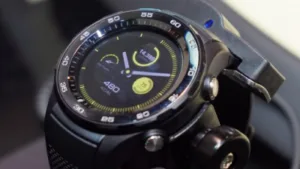Huawei, of course, had a big and busy booth with lots to see. First we looked at the Watch 2 which is the first smart watch to use Android Wear 2 and also uses Qualcomm’s new Snapdragon 2100 chipset. It has a 390 x 390 AMOLED display (326ppi) and includes 4G LTE support for stand-alone voice calls. It also has GPS and is water and dust resistant to IP68. The watch has heart rate tracking and a ‘real time coaching’ mode with real time measurement of oxygen absorption. It claims to be able to calculate the wearer’s VO2 max. The watch has a ceramic bezel, intended to protect the Gorilla Glass lens (from sapphire last time, but is said to reduce the weight). There is a special ‘time only’ mode that is said to make the battery last 25 days, although in ‘normal operation’, battery life is two days.
There are two designs, the Watch 2 (with LTE) and the Watch 2 Classic (without).
The Watch 2 is expected to ship around April for around $379.
 Huawei’s Watch 2 has integrated LTE calling for voice & data as well as strong fitness features including GPS. Image:Meko
Huawei’s Watch 2 has integrated LTE calling for voice & data as well as strong fitness features including GPS. Image:Meko
The TalkBand B3 is a fitness band and BT headset that is designed to be used with an Android or iOS phone. It has a 0.7″ touch OLED with 128 x 80 format that is curved and covered with Gorilla Glass. It’s IP57 rated.
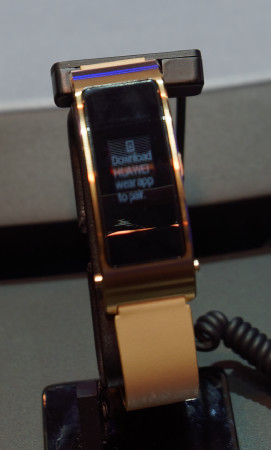
The Honor 8 Pro is the latest in the lower level Huawei phones. The phone has a 5.7″ 1440 x 2560 display (515ppi) based on an LTPS IPS LCD panel. The chipset is a HiSilicon (a subsidiary of Huaewi) Kirin 960 with 4GB or 6GB of RAM and 64GB or 128GB of Flash storage. There are dual 12MP rear cameras with laser and phase detection autofocus and an 8MP front camera. Video capture is up to 2160P at 30fps.
The Honor 8 has a 5.5″ FullHD display and a Kirin 950 processor with 4GB of RAM and 32/64GB of storage. The body is ‘dual glass’ on the front and back and the battery has 3,000mAh of capacity. Charging supports Smart Power 4.0
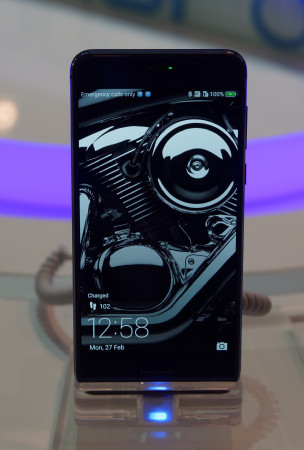 Huawei’s Honor 8. Image:Meko
Huawei’s Honor 8. Image:Meko
The Honor 6 was on display, but we reported on this from CES (CES 2017 Round-Up).
The P10 and P10 Plus are up-market phones that are aimed at those that are looking for good camera performance in a smartphone. Like the LG G6, the P10 and P10 Plus have dual cameras, but in this case the cameras are a 12MP colour sensor and a 20MP monochrome sensor and the camera is the same as in the Mate 9, designed by Leica. A feature is Optical Image Stabilisation (OIS) and laser-assisted autofocus. There is a ‘Leica-style’ portait mode that uses generated ‘bokeh’ (the differential focus look seen on higher end cameras), special illumination and software to ‘beautify’ the subject.
The P10 has a 5.1″ display with FullHD, while the Plus moves that up to 5.5″ and 2560 x 1440 resolution, both using IPS LCDs. Other specifications are like the Honor 8.
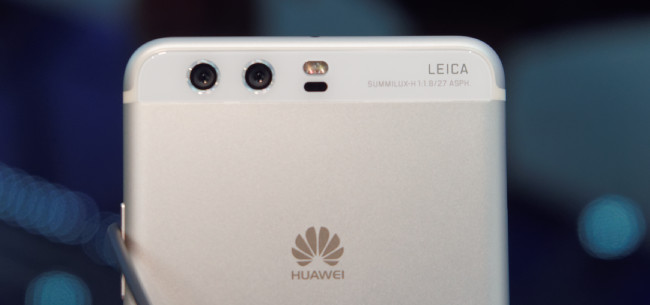 Huawei’s P10 dual Camera designed by Leica and with nice ‘bokeh’ from our Sony camera. Image:Meko
Huawei’s P10 dual Camera designed by Leica and with nice ‘bokeh’ from our Sony camera. Image:Meko
The Porsche Design Mate 9 is a phone that was designed to look stylish and has a high specification. There is a 5.5″ curved 2560 x 1440 display and a Kirin 960 AP, with 6GB of RAM and 256GB of storage. Batter is 4000 mAh and Super Charge is supported. The Mate 9 has the same Leica dual camera as the P10.
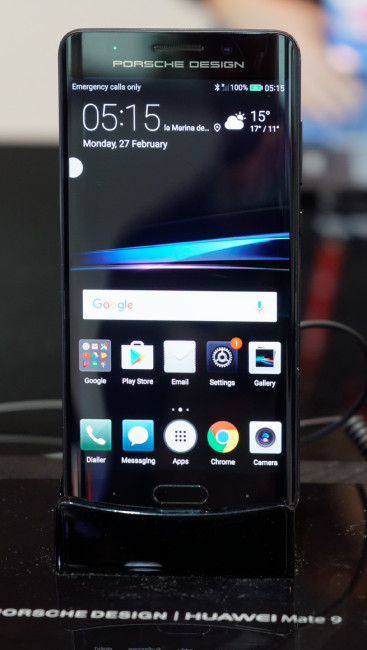 Huawei’s Porsche Mate 9 also has a dual camera. Image:Meko
Huawei’s Porsche Mate 9 also has a dual camera. Image:Meko
Analyst Comment
The Huawei range is impressive and it’s not difficult to see why the company is being taken increasingly seriously in the handset business. (BR)

